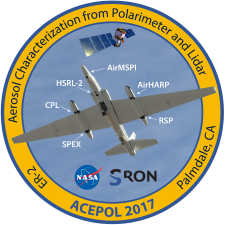The Aerosol Characterization from Polarimeter and Lidar (ACEPOL) campaign performs aerosol and cloud observations over the Western USA in October and November 2017. It is a collaborative effort among the NASA ACE pre-formulation study and the CALIPSO project as well as the Netherlands Institute for Space Research.
ACEPOL’s objective is to assess the capabilities of proposed future instruments by the ACE pre-formulation study to answer fundamental science questions associated with aerosols, clouds, air quality and global ocean ecosystems. Further, it provides reference data to the ongoing CALIPSO satellite mission. ACEPOL results are also relevant to other satellite missions such as EarthCare, MAIA, METOP-SG, and PACE. In particular, ACEPOL will access retrieval of aerosol and cloud microphysical and optical parameters, as well aerosol layer height.
To achieve the ACEPOL objectives, multiple airborne polarimeters (AirHARP, AirMSPI, AirSPEX, and RSP) and lidars (CPL and HSRL-2) are deployed on NASA’s high altitude ER-2 aircraft to simulate satellite remote sensing observations. The ACEPOL data are quantitatively compared between the different instruments, against ground based reference data (AERONET, GroundMSPI, MPLnet, etc.), and against satellite observations (CATS-ISS, MISR, MODIS, CALIPSO). ACEPOL results will enable the development of novel aerosol and cloud retrieval algorithms by unlocking the full information content provided by the combination of active and passive instruments.
Aerosol Characterization from Polarimeter and Lidar (ACEPOL)
Mission

